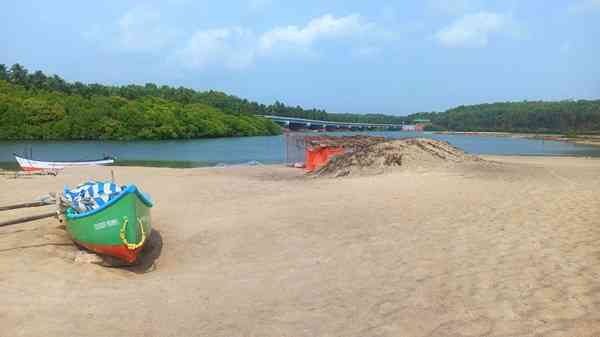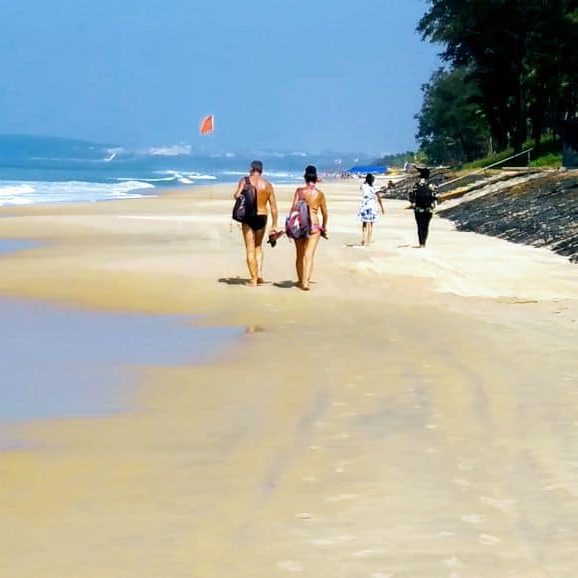
Galgibaga the Turtle Beach | Olive Ridley Turtles 2021
Galgibaga the Turtle Beach | Olive Ridley Turtles 2021
Galgibaga the Turtle Beach, is Paradise on Earth! Located at extreme South Goa at the Karnataka border the first beach while entering from Karnataka into Goa, probably the most beautiful beach of Goa.
And also one of the most underrated beach. Some call it paradise on Earth because of the golden sand and abundance of nature.
Along the long stretch of sand with crystal clear water you will find many sea creatures such as snails, crabs shells etc. playing. Be alert as well, you might find some jellyfish too.
If you are looking to explore the natural beauty then it is a must-visit beach, a great beach for couples a true hidden gem to explore.
What You Can Find Here
No Shacks found on the beach as compared to other beaches in Goa, therefore, the beach surroundings are very clean and calm and most scenic too.
One should preserve the serenity of this place.
This place will make you feel that you are on a private island enjoying the scenic beauty of Galgibaga beach.
At the extreme end of the beach have a look at the beautiful rock formations and enjoy the sound of crashing waves and water splashing.
On the other side, there is a small lagoon with extremely clear water which makes this beach even more memorable to visit, a real photogenic beach.
Galgibaga Distance – From Margao
Drive along NH 66 from Madgao via Karwar Karnataka border. The distance is approximately 44km say about a little more than an hour’s distance.
The other travel options are by train and bus but the most preferred option is either to drive or ride by 2 wheelers.
Watch the video included here to get a clear idea of the road and the beach. If you have previously been to Palolem, Patnem, Agonda beach then the road will be familiar to you as it is the same road leading to Galgibaga Beach.
Turtle Nesting Site – Galgibaga the Turtle Beach
This beach is also famous as the Turtle nesting site or harvesting beach, therefore the government of Goa does not promote any tourists activities, in fact local fishing is also not allowed.
This is the main reason for this beautiful beach for being underrated and secluded.
Galgibaga Beach Restaurants
I spotted few Hotels with lodging facilities that are charging around Rs. 1000 plus per night beside tent camping options including boat fishing. Visit the Namaste India restaurant for mouthwatering seafood at reasonable rates.
Spotted a lifeguard in case you decide to enter into the sharp water for swimming but just be careful when venturing for swimming because the beach is steep and deep which is not the case with other beaches of Goa.
Walk along under the palm trees. The government deserves applause for they have carried out protection works including turtles nesting. This is a beach where we can see the river ending and the river meets the sea.
Find the Glowing Planktons – Galgibaga the Turtle Beach
The stealing point of this beach is you can arrange a boat ride with the locals at the beach who will take you into the sea to a distance to show the wide variety of beautiful looking Planktons. Enjoy the sunsets and cool wind breeze on a super beach for perfect photo shoots.
Rock formation and lagoon at the end of the beach increases its beauty to an extent. If someone is looking to explore the natural beauty one should definitely visit this place in Goa.
Home to Famous Olive Ridley Turtles
The Galgibaga Beach also known as Turtle Beach, Home to famous Olive Ridley Turtles, the beach is actually popular as an Olive Ridley turtle nesting site.
There are people positioned on the beach to ensure the safety of the turtle eggs one of the endangered species.
But if you are going solely to have a glimpse of the turtles then it will disappoint you as there won’t be a single one present during the day since hatching is done only in the nighttime
Sea Turtle Biology – Adaptations – Swimming
The Sea turtles belong to the class Reptilia and Order Testudines. And these Sea turtles are believed to have originated in the lower Mesozoic era and evolved from land-based turtles.
During the late Cretaceous period (About 65 million years ago) four distinct families of sea turtles are believed to have existed, of which two families survived into the current era:
– Dermochelyidae
– Chelonildae
Adaptations
Sea turtles are distributed mostly in tropical and subtropical waters of the world’s oceans and they depend on land only during the reproduction stage.
They are air-breathing vertebrates like birds and mammals but have returned to a near-complete life in the water.
They are considered highly morphologically and have adaptations for life in the sea.
Swimming
All species share features such as paddle-shaped limbs and a streamlined shape with an enlarged shoulder girdle and well-developed pectoral muscles which are an aid in swimming.
Sea turtles are excellent divers. Leatherbacks routinely dive to depths exceeding 1000 feet in search of jellyfish.
Moreover, during long drives, blood is shunted away from tissues tolerant of low oxygen levels toward the heart, brain, and central nervous system.
Unlike other cryptodires, sea turtles have a reduced ability to retract their heads. The shell adaptations are necessary for retractile limbs would impede rapid swimming.
Life History of Sea Turtles – Galgibaga the Turtle Beach
All sea turtles share a similar life cycle although there are variations between species and even better between populations of the species.
Reproduction
Males and female begin the reproduction cycle by migrating from their feeding grounds to breeding grounds which may be separated by several thousand kilometres.
Courtship and mating occur primarily in the offshore waters of the breeding ground, the male mounts on the female holding her with claws in his fore flipper and proceeds to mate. Hence, both males and females may mate with several different individuals.
Emergence of Hatchlings
Sea turtle eggs are incubated by metabolic heat and the heat of the sun. The incubation time for most species is between 45 and 70 days. The eggs then hatch simultaneously over a period of a few days and hatchlings emerge from the nest together usually at night.
Orientation and Navigation
Hatchling emergence is nocturnal to avoid predators and sunlight. Sea finding is visual, the hatchlings seek a brighter horizon which is usually the moon or starlight reflecting off the surface of the sea.
They also use silhouettes of sand dune and trees to orient themselves to wave direction and start to swim against it. During this time, they also get imprinted on the earth’s geomagnetic field.
Hatchlings and adults are sensitive to both magnetic field intensity and magnetic inclination angle. Therefore have a compass sense that enables them to migrate to their natal beaches as adults.
About Less Than One in A Thousand Hatchlings Is Believed To Survive Adulthood
Temperature-dependent sex determination:
The sex of a hatchling is determined by incubation (Nest) temperature. Lower temperatures produce males, higher temperature produces females.
Conclusion
11 Top Tourists Places to Visit in South Goa 2021
Agonda Beach
Netravali Wild Life Sanctuary
Palacio Do Deao
Braganza House
Casa Araujo Alvares
Indian Naval Aviation Museum
Big Foot Museum
Are you interested to learn Konkani? Check this site and learn Konkani easily
How To Learn Konkani Easily – With Phrases
Amigo Shopping is a site that will make you feel to shop on and on. Check the best OFFERS daily
Shop with Amigo Shopping to reach your doorsteps



